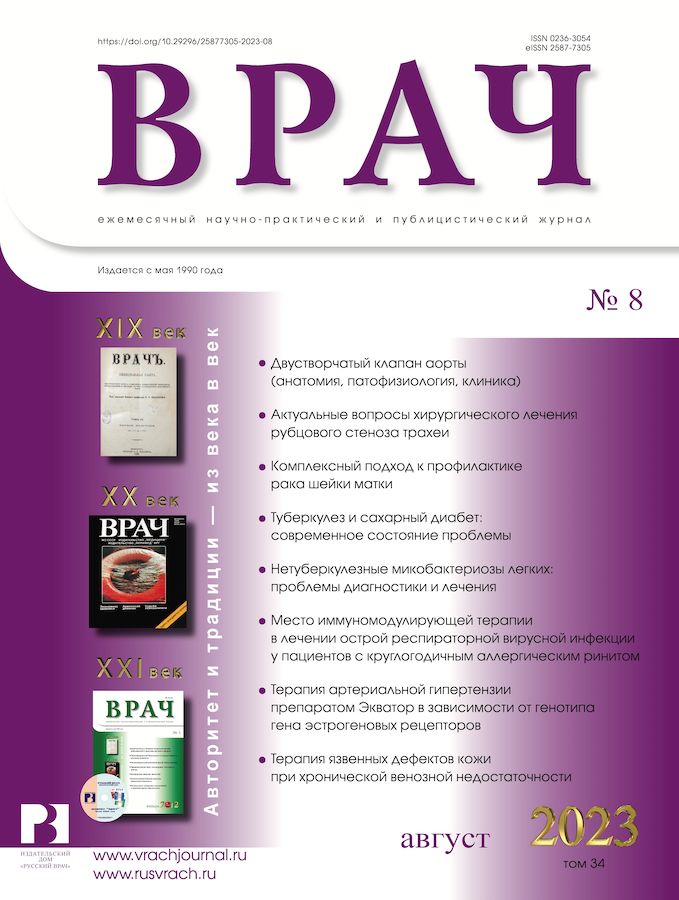Studying the opinion of obstetric and gynecological patients on their communication with medical specialists
- 作者: Amlaev K.R.1, Bakunts S.A.1, Kuzmina E.M.2, Khripunova A.A.1, Dakhkilgova K.T.1
-
隶属关系:
- Stavropol State Medical University, Ministry of Health of Russia
- Ministry of Health of the Stavropol Territory
- 期: 卷 34, 编号 8 (2023)
- 页面: 43-47
- 栏目: Health Care Service
- URL: https://journals.eco-vector.com/0236-3054/article/view/569056
- DOI: https://doi.org/10.29296/25877305-2023-08-08
- ID: 569056
如何引用文章
详细
The paper presents the results of studying the communicative patterns that have developed in everyday obstetric and gynecological practice, as well as the patients’ ideas about them.
Objective. To study the opinion of obstetric and gynecological patients on their communication with medical specialists.
Subjects and methods. A total of 975 patients who were on inpatient treatment in obstetric and gynecological clinics were surveyed.
Results. For older respondents, the absence of tattoos and piercings, as well as the presence of a badge, are important in the appearance of a physician. Almost half of the respondents consider that the physician should comfort an upset patient by giving him the opportunity to vent his negative emotions. To get information on medical topics, most patients use social media; 27.6% are not absolutely interested in social media. 20% of the patients have the impression that the physician talks with him irritably or in a "negative" form; 67% of the patients would like to participate in decision-making with the physician regarding their health.
Conclusion. In order to increase the satisfaction of patients with their interaction with medical specialists, the physicians need to improve their communication skills, pay attention to their image and appearance, and to show empathy when communicating with patients.
全文:
作者简介
K. Amlaev
Stavropol State Medical University, Ministry of Health of Russia
编辑信件的主要联系方式.
Email: kum672002@mail.ru
MD, Professor
俄罗斯联邦, StavropolS. Bakunts
Stavropol State Medical University, Ministry of Health of Russia
Email: kum672002@mail.ru
俄罗斯联邦, Stavropol
E. Kuzmina
Ministry of Health of the Stavropol Territory
Email: kum672002@mail.ru
Candidate of Medical Sciences; Associate Professor
俄罗斯联邦, StavropolA. Khripunova
Stavropol State Medical University, Ministry of Health of Russia
Email: kum672002@mail.ru
Candidate of Medical Sciences; Associate Professor
俄罗斯联邦, StavropolKh. Dakhkilgova
Stavropol State Medical University, Ministry of Health of Russia
Email: kum672002@mail.ru
Candidate of Medical Sciences
俄罗斯联邦, Stavropol参考
- Evans D., Bird E., Gibson A. et al. Extent, quality and impact of patient and public involvement in antimicrobial drug development research: A systematic review. Health Expect. 2018; 21 (1): 75–81. doi: 10.1111/hex.12587
- Ocloo J., Garfield S., Franklin B.D. et al. Exploring the theory, barriers and enablers for patient and public involvement across health, social care and patient safety: a systematic review of reviews. Health Res Policy Syst. 2021; 19 (1): 8. doi: 10.1186/s12961-020-00644-3
- Schattner A., Rudin D., Jellin N. Good physicians from the perspective of their patients. BMC Health Serv Res. 2004; 4 (1): 26. doi: 10.1186/1472-6963-4-26
- Street R.L. Jr., Makoul G., Arora N.K. et al. How does communication heal? Pathways linking clinician-patient communication to health outcomes. Patient Educ Couns. 2009; 74 (3): 295–301. doi: 10.1016/j.pec.2008.11.015
- Apker J., Propp K.M., Zabava Ford W.S. et al. Collaboration, credibility, compassion, and coordination: professional nurse communication skill sets in health care team interactions. J Prof Nurs. 2006; 22 (3): 180–9. doi: 10.1016/j.profnurs.2006.03.002
- Nicolai J., Buchholz A., Seefried N. et al. When do cancer patients regret their treatment decision? A path analysis of the influence of clinicians' communication styles and the match of decision-making styles on decision regret. Patient Educ Couns. 2016; 99 (5): 739–46. doi: 10.1016/j.pec.2015.11.019
- Kraft-Todd G.T., Reinero D.A., Kelley J.M. et al. Empathic nonverbal behavior increases ratings of both warmth and competence in a medical context. PLoS One. 2017; 12 (5): e0177758. doi: 10.1371/journal.pone.0177758
- Laukka E., Huhtakangas M., Heponiemi T. et al. Health Care Professionals' Experiences of Patient-Professional Communication Over Patient Portals: Systematic Review of Qualitative Studies. J Med Internet Res. 2020; 22 (12): e21623. doi: 10.2196/21623
- Kim H., Tietsort C., Posteher K. et al. Enabling Self-management of a Chronic Condition through Patient-centered Coaching: A Case of an mHealth Diabetes Prevention Program for Older Adults. Health Commun. 2020; 35 (14): 1791–9. doi: 10.1080/10410236.2019.1663583
- Jansen R., Reid M. Communication Technology Use by Caregivers of Adolescents With Mental Health Issues: Systematic Review. JMIR Mhealth Uhealth. 2020; 8 (8): e13179. doi: 10.2196/13179
补充文件







